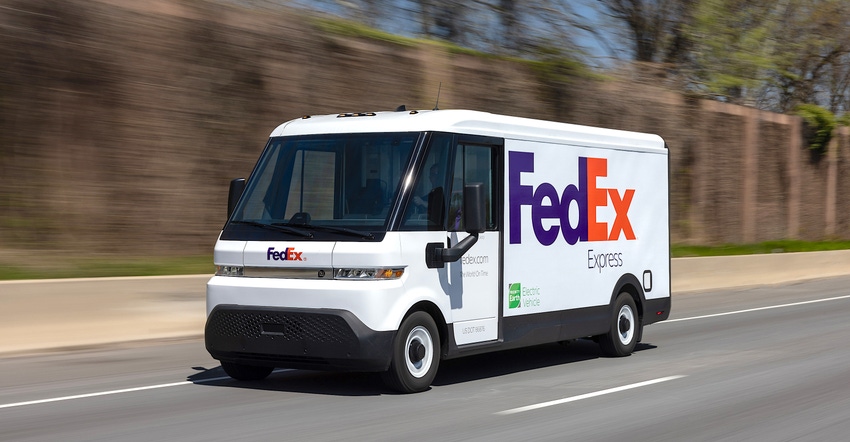BrightDrop's Guinness World Record 260-mile drive has important ramifications for future battery life in fleet use.

General Motors’ BrightDrop electric commercial vehicle subsidiary celebrated Earth Day with a record-setting 260-mile drive from New York to Washington D.C. on a single charge. As every fifth-grader knows, a record isn’t a record until it has been certified by bar-bet-settling experts at Guinness brewing, who’ve branded this an official Guinness World Record.
The van, which will serve as a FedEx parcel delivery van, has been freshly branded the Zevo 600 rather than the original EV600 designation. The “600” portion of the name refers to the van’s cargo capacity in cubic feet. For comparison, the familiar brown UPS trucks are 700 cubic feet.
The 260-mile highway drive doesn’t seem particularly relevant to an urban delivery vehicle’s utility, as low-speed stop-and-go urban driving suffers less aerodynamic drag and presents more opportunity for energy recovery under braking, so the urban driving range could be longer.
However, the ability to make a non-stop drive from New York to Washington does help illustrate that the Zevo 600, 20-module Ultium battery pack has surplus range for urban driving duty. This is important, according to FedEx chief sustainability officer Mitch Jackson, because surplus range means that the vans won’t need to be charged daily and won’t need to be charged to 100 percent every time. Recharge cycles and 100 percent charges are key factors that reduce battery life, so avoiding them is crucial.
“The surplus range gives us the ability to do opportunistic charging,” Jackson explained. “You don’t necessarily have to do a full charge on every vehicle every night. If you can go to 80 percent and meet your [delivery driving] requirements, that’s a key factor for us.”
Fleet operators like FedEx maximize their investment in vehicles by using them for as long as possible, so as they shift to electrified vehicles, being gentle with their batteries will be important for prolonged use. “We like to keep these vehicles a long time,” Jackson said.
The cost of fueling and maintaining these vehicles is another crucial matter for fleet operators like FedEx. Walmart plans to buy 5,000 of the 28-foot Zevo 600s and Verizon Wireless plans to buy a fleet of 20-foot, 410-cubic-foot capacity Zevo 410s. Total BrightDrop orders now top 25,000, according to the company.
In addition to long life, low cost of fuel and maintenance are important to these customers, and BrightDrop predicts annual savings of $7,000 for companies using a Zevo 600 in place of a conventional diesel-powered commercial van. At least, that was the early, conservative estimate. Based on recent increases in fuel prices, “We could see that double,” said BrightDrop chief revenue officer Steve Hornyak.
It isn’t just the fuel that costs less. “EVs are easier to maintain because they have far fewer moving parts,” observed Jackson.

BrightDrop’s challenge is filling all these orders. Currently, the company is outsourcing assembly to Kuka Systems, which was critical to the company’s ability to deliver vans only 20 months after the product announcement. Later this year mass production starts at GM’s CAMI assembly plant in Ontario, Canada.
The speedy development to production was also enabled by BrightDrop’s use of the same components of GM’s Ultium drivetrain as the GMC Hummer EV, Cadillac Lyriq, and other upcoming GM EVs. While the Hummer carries 24 battery modules with a total capacity of 205 kilowatt-hours, the Zevo 600 has 20 of those modules, giving the van a capacity of 170 kWh.
The Zevo 600 can do DC fast charging at 120 kW or for everyday charging can charge at 11.5 kW using an AC Level 2 charger. Its front and rear electric motors deliver 300 horsepower and 390 lb.-ft. of torque through all four wheels. Behind the wheel, this power is delivered smoothly, without the sometimes-abrupt torque hit on startup that causes even economy EVs like the Nissan Leaf to pull away from traffic signals with an unintended tire chirp.
This is because the BrightDrop team’s engineers specifically tailored the power delivery to mimic that of the 6.2-liter GM DuraMax V8 diesel used in trucks today. Drivers who are used to the response they get from their diesel trucks today will get exactly the same experience when they shift to electric power in the future.
The van is well thought out, with a low 15-inch step-in height compared to the typical 18-inch step-in as a greeting. The driver’s seat is high, naturally, with great vision through the expansive windshield and electrically adjustable outside mirrors.

As promised, power delivery is linear, making it easy to pull from the curb uneventfully and silently. The steering is nicely direct for a commercial vehicle and the one-pedal driving that lets the accelerate start and stop the van without the need for using the brake pedal works effectively.
Unlike many commercial vehicles, the Zevo 600 enjoys GM’s full suite of standard safety features such as Front and Rear Park Assist, Automatic Emergency Braking, Forward Collision Alert, Following Distance Indicator, Front Pedestrian Braking, Lane Keep Assist with Lane Departure Warning, IntelliBeam Automatic High Beams, and HD Rear Vision Camera. Additional optional features include Rear Cross-Traffic Braking, Blind Zone Steering Assist, Reverse Automatic Braking, HD Surround Vision, Rear Pedestrian Alert, and Enhanced Automatic Emergency Braking.
In addition to the driver’s side airbags, the Zevo 600 also has airbags for the right-side jump seat, where parcel delivery trucks often carry an assistant during busy surge times such as December.
On the road, there’s quite a bit of rattling from the door that divides the cockpit from the cargo bay, but professional drivers are probably used to that. Some of the welds on the aluminum bulkhead separating the two looked less than proficiently executed, so hopefully, the welders will get better with experience.
If that’s the main challenge for BrightDrop to overcome in the rush to mass production in November, the company can consider this a job well done.
About the Author(s)
You May Also Like





